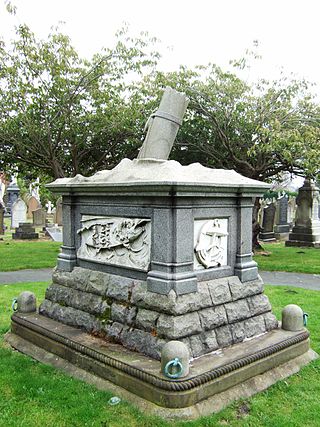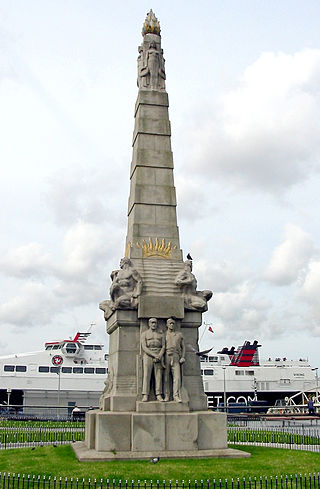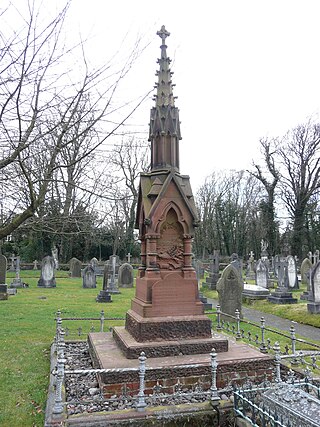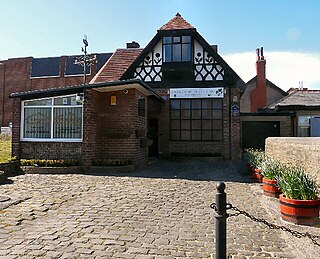
Lytham St Annes is a seaside town in the Borough of Fylde in Lancashire, England. It is on the Fylde coast, directly south of Blackpool on the Ribble Estuary. The population of the built-up area at the 2021 census was 42,695. The town is made up of the four areas of Lytham, Ansdell, Fairhaven and St Annes-on-the-Sea.

The Southport and St Anne's lifeboats disaster, commonly known as the Mexico disaster after the German barque, Mexico was wrecked on the evening of the 9th December 1886. In all, 27 lifeboat men lost their lives trying to save the crew of the ship.

The Wells lifeboat disaster occurred in 1880 when the RNLI lifeboat Eliza Adams, based at Wells-next-the-Sea in the English county of Norfolk, attempted to go to the aid of the stricken brig Ocean Queen in heavy seas and was lost along with 11 of its 13 crew.
Over the years, a number of ships have foundered off Southport. For the purposes of this article, the Southport area shall be considered as Southwards from Lytham St Annes to Freshfield.

The Memorial to Heroes of the Marine Engine Room is a granite monument located on St. Nicholas Place, at the Pier Head, in Liverpool, England.

St Cuthbert's is an Anglican church in Lytham, Lancashire, England. It was built 1834–1835, replacing a previous church on the same site. It is an active parish church in the Diocese of Blackburn. Since 1971 it has been designated a Grade II* listed building.

St Anne's Church is an Anglican church in St Annes-on-the-Sea, a town on the Fylde coastal plain in Lancashire, England. It is an active Church of England parish church in the Diocese of Blackburn and the archdeaconry of Lancaster. It is recorded in the National Heritage List for England as a designated Grade II listed building.

St Annes Pier is a Victorian era pleasure pier in the English seaside resort of St Annes-on-the-Sea, Lancashire. It lies on the estuary of the River Ribble. The pier, designed by Alfred Dowson, was completed in 1885 and was one of the earliest public buildings in St Annes, a 19th-century planned town. The pier was originally intended to be a sedate promenading venue for the resort's visitors, but attractions were later added. Changes made to the estuary channels to improve access to Preston Dock left the pier on dry land and ended its steamer services to Blackpool and Liverpool.

The Lifeboat Memorial, Southport, occupies a central position in Southport Cemetery, Cemetery Road, Southport, Merseyside, England. It commemorates the death of 27 lifeboatmen from Southport and St Annes who were lost in the attempt to rescue the crew of the German barque Mexico that had been driven into a sandbank in a gale in 1886. The memorial is in the form of a tomb chest on a tall plinth with carving and inscribed panels. It is recorded in the National Heritage List for England as a designated Grade II listed building.

The Lifeboat Monument, St Annes, stands on South Promenade, St Annes, Fylde, Lancashire, England. It commemorates the death of 13 lifeboatmen from St Annes who were lost in the attempt to rescue the crew of the German barque Mexico that had been driven into a sandbank in a gale in December 1886. The lifeboat from Southport also lost 14 of its 16 man crew in the disaster. The monument depicts a lifeboatman looking out to sea and standing on a rock-like plinth. It is recorded in the National Heritage List for England as a designated Grade II listed building.

The Lifeboat Memorial, Lytham, is in the churchyard of St Cuthbert's Church, Lytham St Annes, Fylde, Lancashire, England. It commemorates the death of 27 lifeboatmen from Southport and St Annes who were lost in the attempt to rescue the crew of the German barque Mexico that had been driven into a sandbank in a gale in 1886. The memorial is in the form of a Gothic-style tabernacle with a crocketed pinnacle. It is recorded in the National Heritage List for England as a designated Grade II listed building.

Southport War Memorial is in London Square, Lord Street, Southport, Merseyside, England. It consists of an obelisk flanked by two colonnades in the form of Greek temples. Outside the colonnades are memorial gardens, each containing a Pool of Remembrance and fountains. The memorial was designed by the local architects Grayson and Barnish, and the carving was executed by Herbert Tyson Smith. It was unveiled in 1923 by the Earl of Derby. Following the Second World War and subsequent conflicts further inscriptions and names have been added. The memorial is recorded in the National Heritage List for England as a designated Grade II* listed building.
Southport is a seaside town in Sefton, Merseyside, England. It contains 175 buildings that are recorded in the National Heritage List for England as designated listed buildings. Of these, three are listed at Grade II*, the middle of the three grades, and the others are at Grade II, the lowest grade. There are no buildings listed at Grade I.
Lytham is a conurbation in the Borough of Fylde, Lancashire, England that includes the town of Lytham and the districts of Ansdell and Fairhaven. It contains 91 buildings that are recorded in the National Heritage List for England as designated listed buildings. Of these, one is listed at Grade I, the highest of the three grades, four are at Grade II*, the middle grade, and the others are at Grade II, the lowest grade.
St Annes on the Sea is a town in the Borough of Fylde, Lancashire, England. It contains 23 listed buildings that are recorded in the National Heritage List for England. Of these, one is listed at Grade II*, the middle of the three grades, and the others are at Grade II, the lowest grade. Until the 1870s the only buildings in the area now occupied by the town were scattered cottages. In 1873 the architects Maxwell and Tuke were appointed to draw up a plan for the development of the town. This has since grown to become a seaside resort and commuter town. The listed buildings include churches and associated structures, public buildings, a hotel and its boundary wall, memorials, a bank, and a former school. The structures relating to the town's function as a resort are a pier, a pavilion and shelters, fountains, and a bandstand.

Southport Offshore Rescue Trust (SORT) is the registered charity that runs the Southport Independent Lifeboat, a marine and land based search and rescue organisation on the Sefton coastline.

The Eliza Adams Lifeboat Memorial is a grade II listed memorial in Wells-next-the-Sea in Norfolk. It commemorates the death of 11 members of an RNLI lifeboat crew, who died in 1880 when a wave capsized their boat.

St Annes Lifeboat Station is a former lifeboat station, located on Eastbank Road, in the Fylde coast town of St Annes, Lancashire.

Lytham Lifeboat Station is a 'former' lifeboat station,, located in the Fylde coast town of Lytham, Lancashire.

Southport Lifeboat Station is a former lifeboat station, located in the Victorian seaside town of Southport, situated to the south of the River Ribble estuary, historically in the county of Lancashire, now Merseyside.














